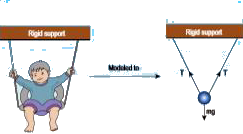Complete Solutions to EXAMPLE of chapter LAWS OF MOTION of Class 11 book with complete answers and questions
| Class 11 | PHYSICS |
| Chapter | LAWS OF MOTION |
| TAMILNADU GOVT | EXAMPLE |
| Number Of Questions | 31 |
| Academic Year | 2023-24 |
A book of mass m is at rest on the table.
What are the forces acting on the book?
View SolutionA book of mass m is at rest on the table.
What are the forces exerted by the book?
View SolutionA book of mass m is at rest on the table.
Draw the free body diagram for the book.
View SolutionIf two objects of masses 2.5 kg and 100 kg experience the same force 5 N, what is the acceleration experienced by each of them?
View SolutionWhich is the greatest force among the three force `vecF_(1),vecF_(2),vecF_(3)` shown below

View SolutionApply Newton’s second law to a mango hanging from a tree. (Mass of the mango is 400 gm)
View SolutionA person rides a bike with a constant velocity `vecc` with respect to ground and another biker accelerates with acceleration `veca` with respect to ground. Who can apply Newton’s second law with respect to a stationary observer on the ground?
View SolutionThe position vector of a particle is given `vecr=3thati+5hatj+7hatk` Find the direction in which the particle experiences net force?
View SolutionConsider a bob attached to a string, hanging from a stand. It oscillates as shown in the figure.
View SolutionTh e velocity of a particle moving in a plane is given by the following diagram. Find out the direction of force acting on the particle?
View SolutionApply Newton’s second law for an object at rest on Earth and analyse the result.
View SolutionA particle of mass 2 kg experiences two forces, `vecF_(1)=8hatj+7hatk and vecF_(2)=3hati-4hatj+3hatk` What is the acceleration of the particle?
View SolutionIdentify the forces acting on blocks A, B and C shown in the figure.
View SolutionConsider a horse attached to the cart which is initially at rest. If the horse starts walking forward, the cart also accelerates in the forward direction. If the horse pulls the cart with force `F_(h)` in forward direction, then according to Newton’s third law, the cart also pulls the horse by equivalent opposite force `F_(c)=F_(h)` in backward direction. Then total force on ‘cart+horse’ is zero. Why is it then the ‘cart+horse’ accelerates and moves forward?
View SolutionThe position of the particle is represented by `y=ut-(1)/(2)"gt"^(2)`.
a) What is the force acting on the particle?
b) What is the momentum of the particle?
View SolutionA baby is playing in a swing which is hanging with the help of two identical chains is at rest. Identify the forces acting on the baby. Apply Lami’s theorem and find out the tension acting on the chain.

View SolutionIdentify the internal and external forces acting on the following systems.
Earth alone as a system
View SolutionIdentify the internal and external forces acting on the following systems.
Earth and Sun as a system
View SolutionIdentify the internal and external forces acting on the following systems.
Our body as a system while walking
View SolutionIdentify the internal and external forces acting on the following systems.
Our body + Earth as a system
View SolutionAn object of mass 10 kg moving with a speed of `15 ms^(-1)` hits the wall and comes to rest within
a) 0.03 second
b) 10 second
Calculate the impulse and average force acting on the object in both the cases.
View SolutionConsider an object of mass 2 kg resting on the floor. The coefficient of static friction between the object and the floor is `us_(s) = 0.8`. What force must be applied on the object to move it?
View SolutionConsider an object of mass 50 kg at rest on the floor. A Force of 5 N is applied on the object but it does not move. What is the frictional force that acts on the object?
View SolutionTwo bodies of masses 7 kg and 5 kg are connected by a light string passing over a smooth pulley at the edge of the table as shown in the figure. The coefficient of static friction between the surfaces (body and table) is 0.9. Will the mass `m_(1) = 7` kg on the surface move? If not what value of `m_(2)` should be used so that mass 7 kg begins to slide on the table?
View SolutionA block of mass m slides down the plane inclined at an angle `60^(@)` with an acceleration `(g)/(2)` . Find the coefficient of kinetic friction?
View SolutionConsider an object moving on a horizontal surface with a constant velocity. Some external force is applied on the object to keep the object moving with a constant velocity. What is the net force acting on the object?

View SolutionIf a stone of mass 0.25 kg tied to a string executes uniform circular motion with a speed of `2ms^(-1)` of radius 3 m, what is the magnitude of tensional force acting on the stone?
View SolutionThe Moon orbits the Earth once in 27.3 days in an almost circular orbit. Calculate the centripetal acceleration experienced by the Moon? (Radius of the Earth is `6.4xx10^(6)m)`
View SolutionConsider a circular leveled road of radius 10 m having coefficient of static friction 0.81. Three cars (A, B and C) are travelling with speed `7 m s^(-1) , 8 ms^(-1) and 10 ms^(-1)` respectively. Which car will skid when it moves in the circular level road? `(g=10 ms^(-2))`
View SolutionConsider a circular road of radius 20 meter banked at an angle of 15 degree. With what speed a car has to move on the turn so that it will have safe turn?
View SolutionCalculate the centrifugal force experienced by a man of 60 kg standing at Chennai? (Given: Latitude of Chennai is`13^(@)`
View Solution
EXAMPLE questions and complete solutions for chapter LAWS OF MOTION of FULL MARKS PHYSICS(TAMIL) of Class 11